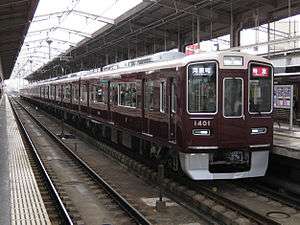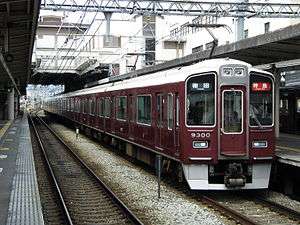Hankyu 1300 series
| Hankyu 1300 series | |
|---|---|
|
Set 1301, July 2014 | |
| Manufacturer | Hitachi |
| Entered service | March 2014 – |
| Number built | 32 vehicles (4 sets) |
| Number in service | 24 vehicles (3 sets) |
| Formation | 8 cars per trainset |
| Fleet numbers | 1300– |
| Capacity | 1,044 per set |
| Operator(s) | Hankyu Corporation |
| Line(s) served |
Hankyu Kyoto Main Line Hankyu Senri Line Osaka Municipal Subway Sakaisuji Line |
| Specifications | |
| Car body construction | Aluminium alloy, double-skin |
| Car length | 18,900 mm (62 ft 0 in) |
| Width | 2,825 mm (9 ft 3.2 in) |
| Height | 4,095 mm (13 ft 5.2 in) |
| Doors | 3 pairs per side |
| Maximum speed | 130 km/h (80 mph) |
| Traction system | Variable frequency (IGBT) |
| Traction motors | Squirrel-cage rotors |
| Acceleration | 2.6 km/h/s |
| Deceleration |
3.7 km/h/s (service) 4.2 km/h/s (emergency) |
| Electric system(s) | 1,500 V DC |
| Current collection method | Pantograph |
| Bogies | FS579M (motored), FS579T (trailer) |
| Braking system(s) | Electric commanding, regenerative brakes |
| Safety system(s) | ATS, WS-ATC |
| Coupling system | Shibata-type |
| Track gauge | 1,435 mm (4 ft 8 1⁄2 in) |
The Hankyu 1300 series (阪急電鉄1300系 Hankyū 1300-kei) is a commuter electric multiple unit (EMU) train type operated by the private railway operator Hankyu Corporation on Hankyu Kyoto Main Line services since March 2014.[1]
Overview
Based on the 9000 series and 9300 series EMUs first introduced in 2003, the 8-car 1300 series trains are manufactured by Hitachi and have aluminium alloy bodies with a double-skin construction.[2] Externally, the trains are finished in the standard Hankyu colour scheme of all-over maroon.[2]
Formation
The eight-car trains are formed as shown below, with four motored (M) cars and four non-powered trailer (T) cars, and car 1 at the Umeda end.[3][4]
| Designation | Tc | M | M' | T | T | M | M' | Tc |
|---|---|---|---|---|---|---|---|---|
| Numbering | 1300 | 1800 | 1900 | 1350 | 1450 | 1850 | 1950 | 1400 |
| Weight (t) | 30.0 | 35.3 | 33.6 | 27.2 | 27.2 | 35.3 | 33.6 | 30.0 |
| Capacity (Total/seated) | 123/43 | 133/49 | 133/49 | 133/49 | 133/49 | 133/49 | 133/49 | 123/43 |
The "M" cars (1800 and 1850) each have two single-arm pantographs.[3]
Interior
Passenger accommodation consists of longitudinal bench seating throughout, with "golden olive" coloured moquette seat covers.[2] Internally, the trains use LED lighting throughout.[3] Each car includes a wheelchair space at one end.[3]
History
The first set, 1300, entered revenue service from 30 March 2014.[5]
Fleet history
The fleet history is as shown below.[4]
| Set No. | Manufacturer | Date delivered |
|---|---|---|
| 1300 | Hitachi | 28 March 2014 |
| 1301 | Hitachi | March 2014 |
| 1302 | Hitachi | September 2014[6] |
| 1303 | Hitachi | January 2015[7] |
See also
- Hankyu 1000 series, a similar variant used on the Kobe/Takarazuka Lines from November 2013
References
- ↑ 新型車両1000系 [New 1000 series]. 1000 series special site (in Japanese). Japan: Hankyu Corporation. 28 November 2013. Retrieved 28 November 2013.
- 1 2 3 新型車両1000系・1300系をこの秋より導入します! [New 1000/1300 series trains to be introduced from autumn] (PDF). News release (in Japanese). Japan: Hankyu Corporation. 6 June 2013. Retrieved 7 June 2013.
- 1 2 3 4 阪急電鉄1000・1300系 [Hankyu 1000 & 1300 series]. Japan Railfan Magazine (in Japanese). Vol. 54 no. 634. Japan: Koyusha Co., Ltd. February 2014. pp. 69–75.
- 1 2 私鉄車両編成表 2014 [Private Railway Rolling Stock Formations - 2014] (in Japanese). Japan: Kotsu Shimbunsha. 24 July 2014. p. 140. ISBN 978-4-330-48414-3.
- ↑ 阪急1300系が営業運転を開始 [Hankyu 1300 series enters revenue service]. Japan Railfan Magazine Online (in Japanese). Japan: Koyusha Co., Ltd. 31 March 2014. Retrieved 1 April 2014.
- ↑ 阪急1300系第3編成が搬入される [Third Hankyu 1300 series set delivered]. Japan Railfan Magazine Online (in Japanese). Japan: Koyusha Co., Ltd. 19 September 2014. Retrieved 30 January 2015.
- ↑ 阪急1300系第4編成が陸送される [Fourth Hankyu 1300 series set delivered]. Japan Railfan Magazine Online (in Japanese). Japan: Koyusha Co., Ltd. 30 January 2015. Retrieved 30 January 2015.
External links
| Wikimedia Commons has media related to Hankyu 1300 series. |
- Hankyu 1000/1300 series (Japanese)

